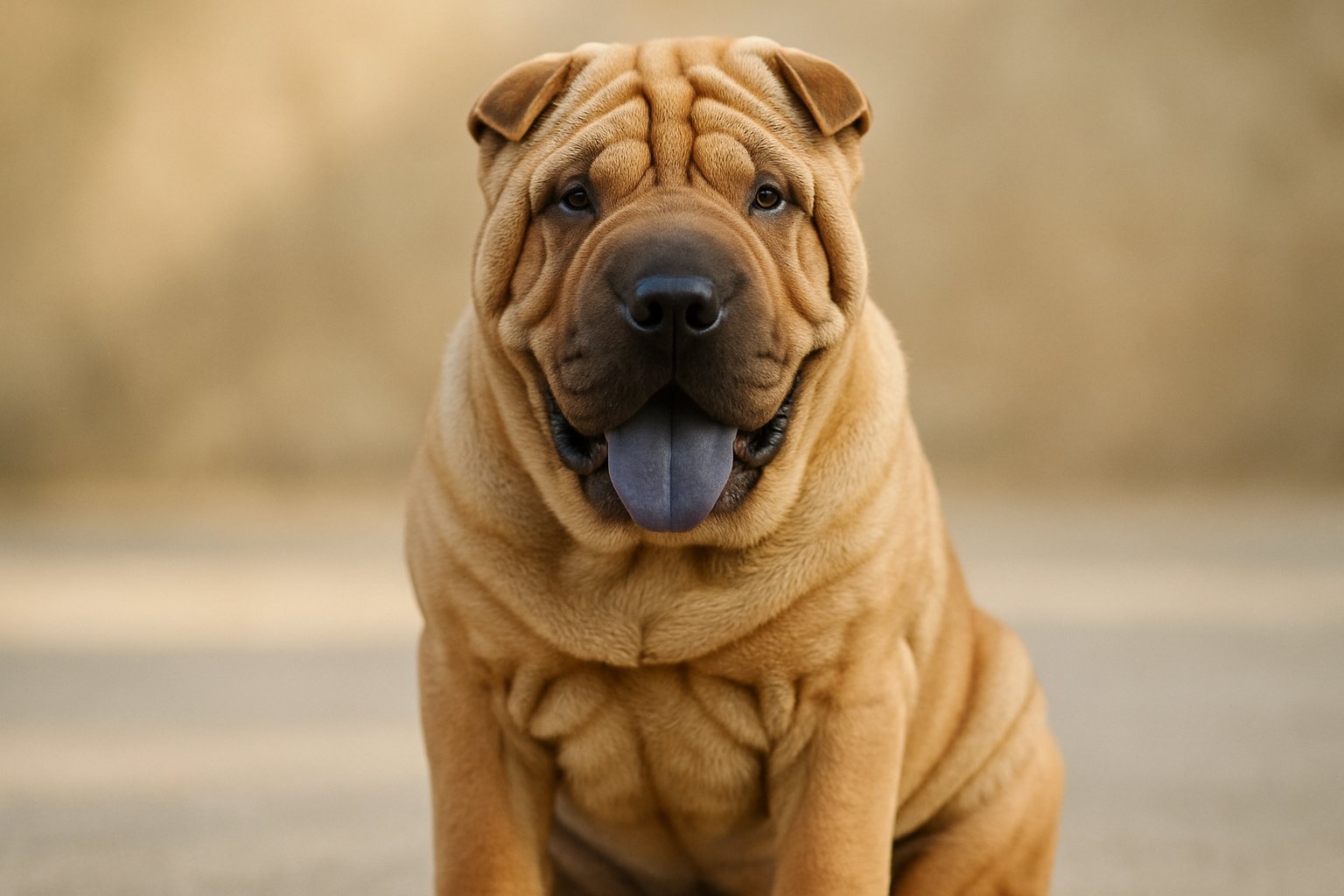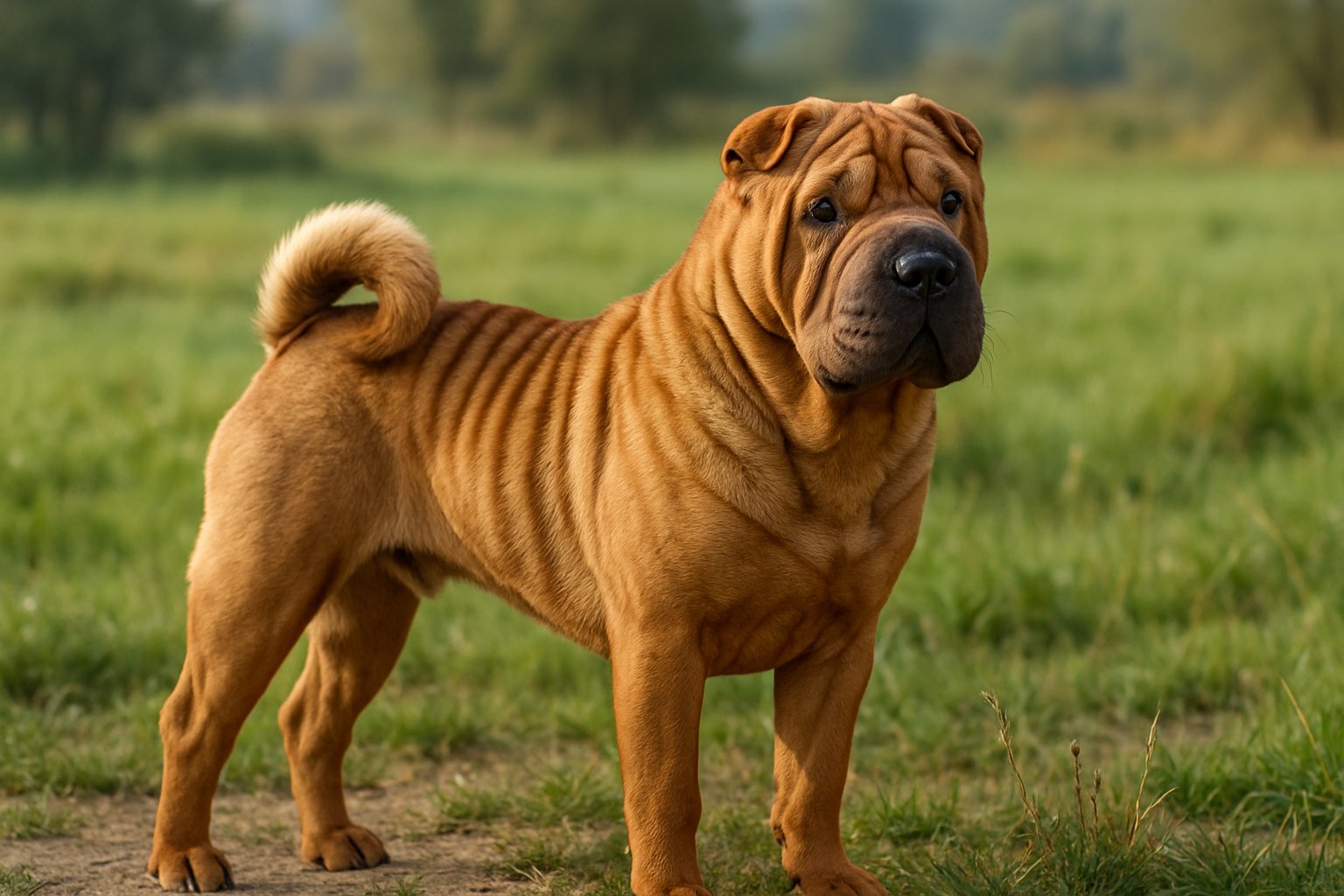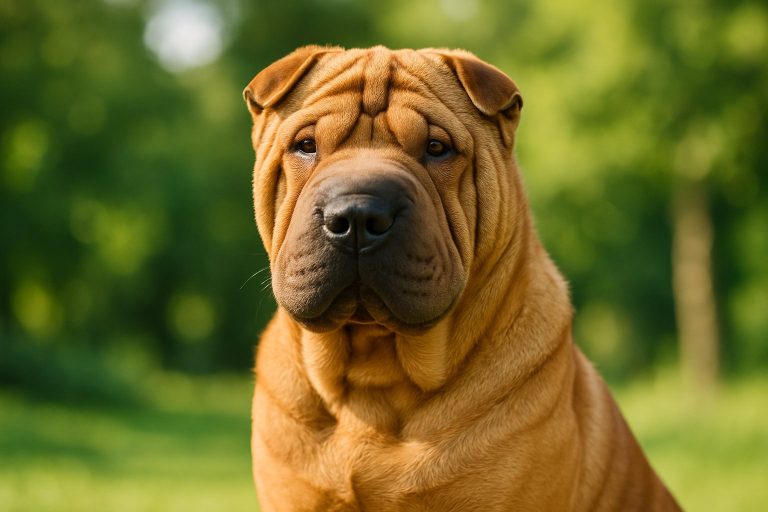Are you curious about the unique features and background of the Chinese Shar-Pei? This breed stands out for its deep wrinkles, blue-black tongue, and fascinating history.
Learning key facts about the Shar-Pei will help you understand what makes this dog special and whether it’s the right breed for you. You’ll discover important and interesting details as you explore the top 12 facts about the Chinese Shar-Pei.
1. The Chinese Shar-Pei is over 2,000 years old, originating during the Han Dynasty.
- When you look at a Chinese Shar-Pei, you are looking at a breed with a very long history. This dog comes from southern China and is more than 2,000 years old.
- The Shar-Pei can be traced back to the Han Dynasty, which lasted from 206 BC to 220 AD. Artifacts and tomb carvings from this time period show dogs that look a lot like today’s Shar-Pei.
- Ancient people in China bred the Shar-Pei to help out on farms. These dogs were used for herding, hunting, and protecting property. Their special appearance, with deep wrinkles and a rough coat, made them stand out and helped them in their work.
- Even though thousands of years have passed, you can still see the connection between today’s Shar-Pei and its ancient ancestors. The breed’s long history is one of the reasons it is so unique among dogs.
2. They have a distinctive blue-black tongue, similar to the Chow Chow.
- One of the first things you might notice about the Chinese Shar-Pei is its unique tongue color. Its tongue is a solid blue-black, which is rare in the dog world.
- This feature is most commonly seen in the Chow Chow, making these two breeds easy to mix up at times. However, there is no proven genetic link between them for this trait.
- The blue-black tongue is not just for appearance. In Chinese folklore, the Shar-Pei’s black tongue was believed to ward off evil spirits and ghosts. People valued the breed for this protective quality.
- If you see a Shar-Pei sticking out its tongue, you will notice the unusual color right away. Unlike most dogs with pink tongues, the blue-black shade sets the Shar-Pei apart from almost all other breeds.

3. The breed’s signature feature is its deep, loose wrinkles, especially as puppies.
- When you see a Chinese Shar-Pei, the first thing you will probably notice is its wrinkled skin. These wrinkles are most dramatic when the dogs are puppies. As they grow, the wrinkles often become less pronounced, but many still keep loose skin around the head and shoulders.
- The wrinkles are not just for looks. Historically, these deep folds helped protect the dogs in fights, making it harder for another animal to grab onto them. If the Shar-Pei was grabbed, its loose skin helped it twist and escape.
- A Shar-Pei puppy’s wrinkles can cover much of its face, neck, and body, creating a unique and memorable appearance. The skin is soft and velvety to the touch. If you want to learn more about the science behind these wrinkles, you can read about why the Shar Pei has wrinkles.
- These wrinkles require proper care. Moisture and dirt can get trapped in the folds, which means you need to keep the skin clean and dry to avoid irritation or infections. Regular cleaning is important for the dog’s health and comfort.
- The Shar-Pei’s wrinkles have played a big role in its identity for centuries. This distinctive look sets the breed apart and is one reason why so many people find the Shar-Pei unique and interesting.
4. Originally bred to herd, hunt, and guard livestock in China.
The Chinese Shar-Pei was first developed in ancient China. People bred these dogs for practical farm work rather than just companionship. You would see the Shar-Pei helping farmers by herding animals. They knew how to guide livestock without being too aggressive. Shar-Peis were also used as hunting dogs. They could track and help catch wild game for their owners.
5. Shar-Peis were used as guard dogs to protect against predators and thieves.
- You might be surprised to learn that Shar-Peis were not just pets. Their main job was to guard homes, livestock, and people in ancient China. They had to be alert and brave to do this work well.
- Shar-Peis were bred for their protective nature. People relied on them to keep away predators and stop thieves from stealing animals or goods. Their loyalty made them trusted guardians.
- The breed’s loose, wrinkled skin gave them extra protection. If another animal tried to grab them, their skin helped them twist and fight back. This trait was useful when they were defending their family or territory against threats.
- Shar-Peis have a strong sense of territory. This natural behavior made them good at noticing anything out of the ordinary. Even today, you can see these guarding instincts in many Shar-Peis.
- Because of their history, these dogs are often cautious around strangers. If you want a dog that can alert you to unusual activity, a Shar-Pei has the background to do the job. You can read more about their guarding role during ancient times at AKC’s article on Shar-Peis and IHeartDogs’ explanation of their heritage.
6. The breed nearly went extinct during China’s Communist Revolution.
When the Communist government took over China in the mid-20th century, dog ownership was seen as a luxury. Heavy taxes were put on owning dogs, making it hard for most families to keep pets. This policy affected many breeds, but the Chinese Shar-Pei was hit especially hard. As a result, the number of Shar-Pei in China dropped quickly. By the 1970s, the breed was nearly gone in its homeland. Reports from that time show only a small number remained in China and nearby places like Hong Kong and Taiwan.
7. Shar-Peis have a calm yet loyal temperament, making them good companions.
- When you bring a Shar-Pei into your home, you’ll notice how calm they are in most situations. They don’t get overly excited and tend to stay composed, even around strangers. This steady nature helps them adjust well to different living environments.
- You can depend on a Shar-Pei to be devoted to their family. These dogs form close bonds and are very loyal to the people they live with. They may be reserved at first, but once they trust you, Shar-Peis show strong dedication.
- Shar-Peis are also known for being independent thinkers. They are not clingy, but they like being near their owners and want to be involved in family life. Their protective instincts show, especially if they think their home or people are at risk.
- While they look serious with their wrinkled faces, Shar-Peis can be affectionate in quiet ways. You won’t see them constantly begging for attention, but they show love through calm companionship and by staying nearby. Shar-Peis’ stable and loyal personality makes them good companions for many families.
8. Their short, bristly coat is unusual compared to other breeds.
The Chinese Shar-Pei has a coat that feels rough and stiff, almost like sandpaper. This unique texture sets them apart from most other dog breeds, which usually have smoother or silkier fur. Their coat comes in three types: horse, brush, and bear. The horse coat is the most common and is very short and harsh to the touch. The brush coat is slightly longer but still somewhat rough, while the bear coat is rare and much longer, giving the dog a fluffy look.
9. They require regular skin care to prevent infections in their wrinkles.
- You need to pay close attention to your Chinese Shar-Pei’s skin. Their deep wrinkles can trap moisture, dirt, and debris, which creates the perfect place for bacteria and yeast to grow. This can lead to skin infections if you don’t take care of their folds properly.
- Cleaning their wrinkles should be part of your regular routine. Use a soft, damp cloth to wipe between the folds and always dry them well. Leaving even a little bit of moisture can increase the risk of skin problems.
- Shar-Peis often need special shampoos to help keep their skin healthy. After baths, make sure to dry every wrinkle completely. This small step can make a big difference in preventing infections.
- Brushing their coat at least once a week helps remove loose hairs and dirt. Regular checks for redness, odor, or swelling in the folds can help you catch skin issues early. If you notice signs of infection, such as redness or a bad smell, it is best to contact your vet for advice.
10. Shar-Peis are known for being independent but can be trained effectively.
Shar-Peis have a strong independent streak. They like to think for themselves and can be a bit stubborn at times. This means you need to be patient and consistent when training them. Even though they can be willful, Shar-Peis are also intelligent dogs. With the right approach, you can teach them basic commands and good manners. Using positive reinforcement works best with this breed.

11. They have a unique ‘hippopotamus’ face shape due to their broad muzzle.
- When you look at a Chinese Shar-Pei, one of the first things you notice is its broad, flat muzzle. This feature gives the breed a “hippopotamus” face shape, which is quite rare among dogs.
- Their face is not just wide, but also flat and deep, helping to set them apart from other breeds. This shape is paired with small, triangular ears and dark, almond-shaped eyes that are sunken, giving the dog a serious look.
- The combination of their broad muzzle and loose, wrinkled skin around the face adds to their unique appearance. Many owners are drawn to the Shar-Pei for this very reason. You can learn more about these facial features in this detailed Shar-Pei breed overview.
- These physical traits come from the breed’s ancient history and have been preserved over time. If you want a dog with a distinctive and easily recognizable look, the Shar-Pei’s “hippopotamus” face is a main reason they stand out in the dog world.
12. This breed has a strong protective instinct towards its family.
You can expect the Chinese Shar-Pei to be highly loyal and protective of your family. This breed was originally developed as a guard dog in China, so looking after its home and loved ones comes naturally. Shar-Peis tend to be watchful. They will quickly notice anything or anyone unfamiliar around their territory. Their strong sense of territory makes them effective at alerting you to strangers or unusual activity.


